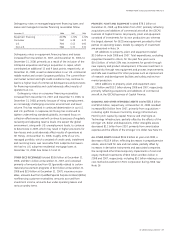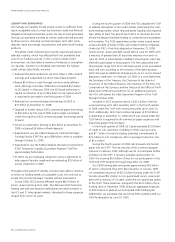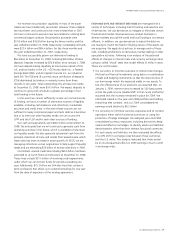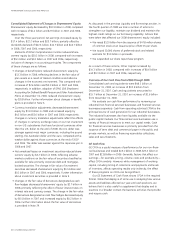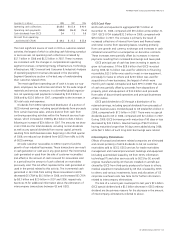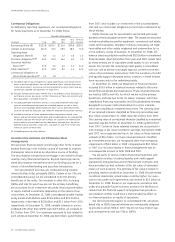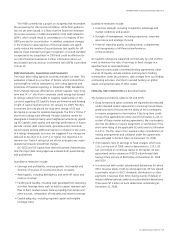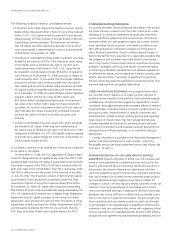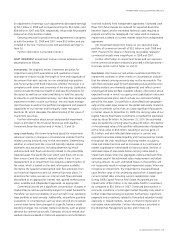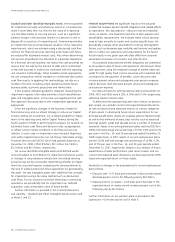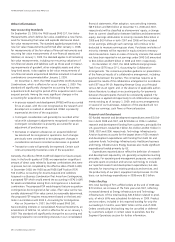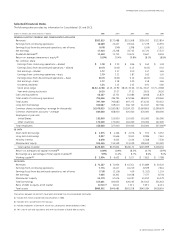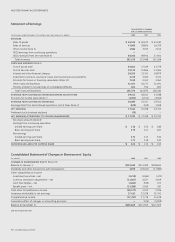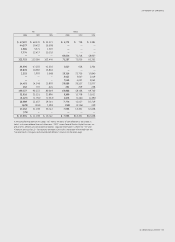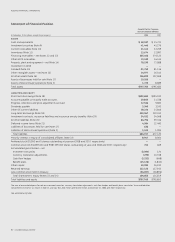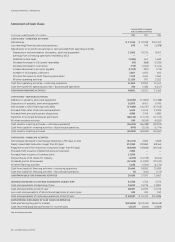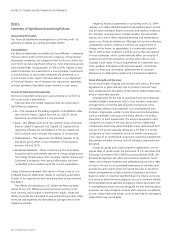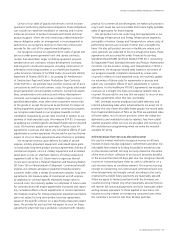GE 2008 Annual Report Download - page 49
Download and view the complete annual report
Please find page 49 of the 2008 GE annual report below. You can navigate through the pages in the report by either clicking on the pages listed below, or by using the keyword search tool below to find specific information within the annual report.management’s discussion and analsis
ge 2008 annual report 47
In evaluating whether a particular relationship qualifies for
hedge accounting, we test effectiveness at inception and each
reporting period thereafter by determining whether changes in
the fair value of the derivative offset, within a specified range,
changes in the fair value of the hedged item. If fair value
changes fail this test, we discontinue applying hedge accounting
to that relationship prospectively. Fair values of both the deriva-
tive instrument and the hedged item are calculated using inter-
nal valuation models incorporating market-based assumptions,
subject to third-party confirmation.
At December 31, 2008, derivative assets and liabilities were
$12.6 billion and $5.2 billion, respectively. Further information
about our use of derivatives is provided in Notes 18, 23 and 29.
INVESTMENTS MEASURED AT FAIR VALUE IN EARNINGS include
retained interests in securitizations accounted for under SFAS 155,
Accounting for Certain Hybrid Financial Instruments, and equity
investments of $2.6 billion at year-end 2008. The earnings effects
of changes in fair value on these assets, favorable and unfavorable,
will be reflected in the period in which those changes occur. As
discussed in Note 17, we have businesses that are held for sale
valued at $2.7 billion at year-end 2008, which represents the
estimated fair value less costs to sell. Those sales are expected
to close in the first quarter of 2009. As discussed in Note 16, we
also have assets that are classified as held for sale in the ordinary
course of business, primarily credit card receivables, loans and
real estate properties, carried at $5.0 billion at year-end 2008,
which represents the lower of carrying amount or estimated fair
value less costs to sell. To the extent that the estimated fair value
less costs to sell is lower than carrying value, any favorable or
unfavorable changes in fair value will be reflected in earnings in
the period in which such changes occur.
OTHER LOSS CONTINGENCIES are recorded as liabilities when it is
probable that a liability has been incurred and the amount of the
loss is reasonably estimable. Disclosure is required when there is
a reasonable possibility that the ultimate loss will materially
exceed the recorded provision. Contingent liabilities are often
resolved over long time periods. Estimating probable losses
requires analysis of multiple forecasts that often depend on
judgments about potential actions by third parties such as
regulators.
Further information is provided in Notes 20 and 31.
INCOME TAXES. Our annual tax rate is based on our income,
statutory tax rates and tax planning opportunities available to us
in the various jurisdictions in which we operate. Tax laws are
complex and subject to different interpretations by the taxpayer
and respective governmental taxing authorities. Significant judg-
ment is required in determining our tax expense and in evaluating
our tax positions, including evaluating uncertainties under FIN 48,
Accounting for Uncertainty in Income Taxes. We review our tax
positions quarterly and adjust the balances as new information
becomes available. Our income tax rate is significantly affected
by the tax rate on our global operations. In addition to local
country tax laws and regulations, this rate depends on the extent
earnings are indefinitely reinvested outside the United States.
Indefinite reinvestment is determined by management’s judgment
about and intentions concerning the future operations of the
company. Deferred income tax assets represent amounts available
to reduce income taxes payable on taxable income in future years.
Such assets arise because of temporary differences between the
financial reporting and tax bases of assets and liabilities, as well
as from net operating loss and tax credit carryforwards. We eval-
uate the recoverability of these future tax deductions and credits
by assessing the adequacy of future expected taxable income from
all sources, including reversal of taxable temporary differences,
forecasted operating earnings and available tax planning strategies.
These sources of income inherently rely heavily on estimates.
We use our historical experience and our short and long-range
business forecasts to provide insight. Further, our global and
diversified business portfolio gives us the opportunity to employ
various prudent and feasible tax planning strategies to facilitate
the recoverability of future deductions. Amounts recorded for
deferred tax assets related to non-U.S. net operating losses, net
of valuation allowances, were $1.8 billion and $1.7 billion at
December 31, 2008 and 2007, respectively. Such year-end 2008
amounts are expected to be fully recoverable within the applicable
statutory expiration periods. To the extent we do not consider it
more likely than not that a deferred tax asset will be recovered,
a valuation allowance is established.
Further information on income taxes is provided in the
Operations —Overview section and in Notes 7 and 21.
DERIVATIVES AND HEDGING. We use derivatives to manage a vari-
ety of risks, including risks related to interest rates, foreign
exchange and commodity prices. Accounting for derivatives as
hedges requires that, at inception and over the term of the
arrangement, the hedged item and related derivative meet the
requirements for hedge accounting. The rules and interpreta-
tions related to derivatives accounting are complex. Failure to
apply this complex guidance correctly will result in all changes in
the fair value of the derivative being reported in earnings, with-
out regard to the offsetting changes in the fair value of the
hedged item.


